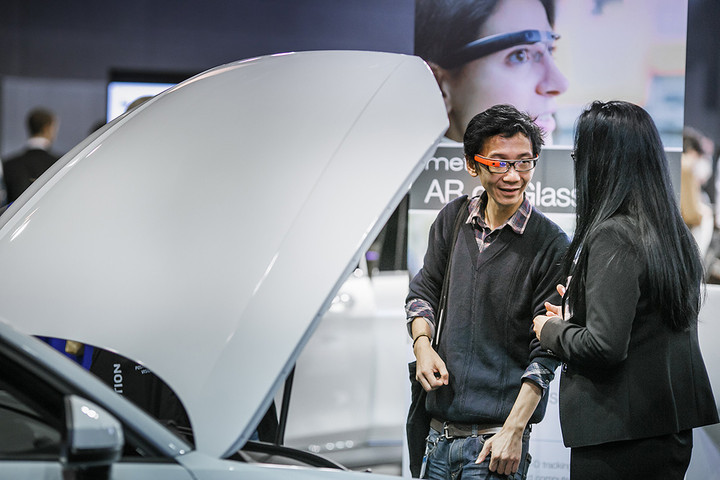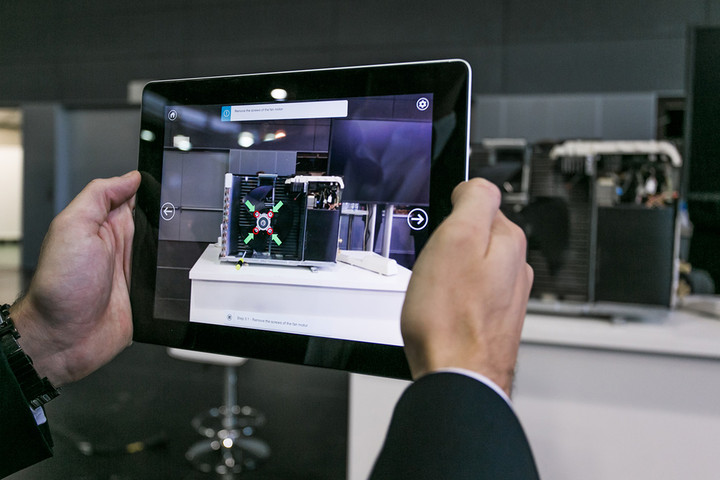(iTers News) - You are not good at car mechanics, and even have no idea on how to check and replace engine oil, or washer fluids. Neither do you know how to recharge your car battery on the road, when it is drawn out. Don’t worry anymore.
Here comes world’s first AR, or augmented reality hand-free car maintenance apps on Google Glass.
Developed by Metaio, Ltd. for example, the AR app allows Google Glass-clad car owners to AR technology shows how to check the leftovers of engine oil fluids and refill them by overlaying real car engine block with its virtual digital schematic image to deliver addition information.
As a wealth of new form factor devices like smart watches and Google Smart Glass hit markets, the penetration of AR technology is gaining speed. Accordingly, its applications areas are rapidly expanding, promising to revolutionize the way that people interact with machines.
World's first hands-free AR car manual
At an opening keynote speech for the 2013 Inside AR conference held in Munich, Germany from Oct. 10 to 11, Thomas Alt, CEO and co-founder with Metaio, “ For us, AR has always been new user interface. For the past decades, AR was rested in these small applications industrial field for design spaces mostly running on PCs. 5 to 6 years ago, wearable devices and smart phones came to AR. In the last 12 months, we have seen great importance on devices like smart phones and head-on-display in AR domain. Our sponsors and partners in that domain will show new devices which will truly empower AR,”
Added he, “It’s not only about form factors, but also devices. But it is also about a technology enabler. Obviously, Metaio puts great emphasis on brining hardware and software to AR.”
According to him, AR is new user interface that has many applications, and is always subject to users. For example, AR applications have been going beyond traditional micro usage cases for tracking and superimposing of small areas into macro user cases of tracking large outdoor and indoor areas, seeing new user cases emerge rapidly.
One prime example is European furniture maker Ikea’s AR catalog that allows users to scale and play virtual furniture in their living room, and then interact with them to check prices and other information.
European luxury car Audi also demonstrates a car manual and maintenance AR, which enables car owners not only to use their smart phones to superimpose real car dash boards and an interior equipment, but also san under-hood engine blocks to get additional information on car manuals.
World's first AR browse on Google Glass
BMW and Mercedes Benz go one step further. BMW and Metaio has implemented together world’s first productive AR car manual system on its Volkswagen series of car models for service technicians. Called as Marta, the 2D and 3D AR system visualizes and overlay animated service instructions to tell service technicians how to repair car. The system works with iPad, so that all he service technicians have to do is jus to hold their iPad and approach in front of the car to get information on where an how to repair.
Mercedes Benz showcased a full-functional prototype of AR-based in-vehicle car infotainment systems, too. The car owner will be able to use the AR technology as a user interface to interact with car navigation system to find the destination to go.
Metaio also came up with what’s called as the world’s first AR browse on Google Glass. Called as Junaio, the system can allow Google Glass-cald users to reference their real world’s point-interest with their digital expression of images and videos stored in remotely located server computers and overlay them to get more detail information.
Yet, AR has still a long way to go before it hit critical mass. The toughest challenge is how to reduce power and heat dissipation when users play AR apps on their smart phones, tablet and wearable devices like Google Glass. .
True enough, activating and playing AR apps on smart phones , or tablet PCs requires huge amount of power, quickly draining their battery life to the bottom, as it must activate a build-in camera system, MEMS motion-tracking sensors like gyroscope, and a display panel. Moreover, it calls for a host CPU to whiz up so fast to render and play out pixel-rich 3D images, guzzling a battery power.
Runs just for 50 minutes
For example, running Junaio AR browser on Google Glass so quickly guzzles up its battery power that it only survives 50 minutes, according to Metaio. “It just run for 50 minutes, and it will be hot. And your battery will be empty,” said Peter Meier, CTO with Metaio. When it comes to running AR apps on a normal smart phone, its battery life just run for one and half a hours.
Metaio said that it has developed AREngine 2 technology, which can extend a smart phone’s battery life to up to 10 hours.
Yet, extending a battery life on an AR-enabled wearable devices requires technology breakthroughs on many areas. For one thing, a display must be a lot power-thriftier than today’s mainstream LCD panel. So, development works are under way to commercialize a tiny micro-mirror display technology like LCOS.
For another, an ultra-low power, multi-core and computational image processor chip is another must-have.
That’s where the likes of Nvidia, Intel Corp. and Movidius are working hard on.




